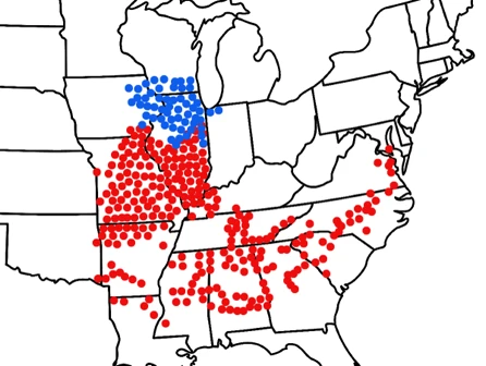
The Cicadas are Coming
United States residents who live in the central states are about to experience a rare event – the emergence of two specific cicada broods with different lifecycles that co-emerge only every 221 years.
Periodical cicadas are insects found in North America that belong to the order Hemiptera which includes aphids, stink bugs, bed bugs, and cicada family.
They are unique in that they have a long life cycle. After hatching, the immature cicadas, called nymphs spend 13 or 17 years underground. The nymphs feed on root juices before emerging in May, 13 or 17 years later. The nymphs emerge from the soil when soil temperature reaches 64 degrees Fahrenheit. Once they emerge, the nymphs molt and then over 3 to 4 days “harden” completely into mature adults.
The males make a loud noise, (called a song or chorus) to attract females. Mated females then create egg nests in living twigs. A female may lay as many as 600 eggs. After 6 to 10 weeks the eggs hatch into nymphs which drop from the trees and burrow underground. The nymphs then begin the long 13 to 17 year development. The adult cicadas die as the nymphs are hatched.
Billions or even trillions of cicadas will emerge over the next couple of weeks in the central US. The noise created by the males can be deafening and can last for 7 to 14 days. The insects are not a menace to humans but can damage trees. They don’t bite, sting, of carry diseases. The nymph emergence tunnels provide important aeration of the soil, and the adult cicadas are a food source for other predators. The dead adults return a large amount of nitrogen to the soil.
There are three species of 17-year cicadas and four species of 13-year cicadas. Groups of cicadas that share the same emergence years are called broods. This year for the first time since 2015 a 13-year brood and a 17-year brood will emerge in the same year. For the first time since 1803 (when Thomas Jefferson was President) Brood XIX and Brood XIII will co-emerge.
The past emergence of Brood XIII and Brood XIX is shown in this map:

Dr. Gene Kritsky, Cicada Safari, cicadasafari.org, 2024.
Learning More About Cicadas
Here are some resources if you want to explore Cicadas further:
Cicada Safari
Dr. Gene Kritsky, Professor of Biology, emeritus at Mount St. Joseph University in Cincinnati has developed this informative website about periodical cicadas. They have also developed an app to help record the emergence of cicadas in the central United States. Citizen scientists are encouraged to download the app and to “go on a local safari” to find periodical cicadas and help the scientists document the cicadas’ locations. They want you to use the app to photograph the cicadas and submit to Cicada Safari. The photos will be verified and posted to a live map to record this rare event. (Reviewing the map today there have been no sightings in central Arkansas and the Little Rock area, but the emerged Brood XIX has been seen in Southern and far Northern Arkansas).
The University of Connecticut
The University has a comprehensive website on the 2024 periodical cicada emergence.
Read this Scientific Review
Simon, et al., Advances in the Evolution and Ecology of 13- and 17-Year Periodical Cicadas, Annual Review of Entomology, 67:457-482, 2022. The most recent scientific review of cicada biology.
Cicada Mania
Check out this popular website with all things cicada.
Try a Cicada Craft
For a fun activity, you can make an Origami Cicada.
I hope you can experience the periodical cicadas emergence. Consider downloading the Cicada Safari app from the Apple app store or Google play.
Ralph Broadwater, M.D., CFP®
![]()
© 2024 The Arkansas Financial Group, Inc., All rights reserved.
The Arkansas Financial Group, Inc. is a Fee-Only Financial Planning Firm located in Little Rock, AR serving clients in Arkansas and throughout the country.
Please remember that past performance may not be indicative of future results. Different types of investments involve varying degrees of risk, and there can be no assurance that the future performance of any specific investment, investment strategy, or product (including the investments and/or investment strategies recommended or undertaken by The Arkansas Financial Group, Inc. [“AFG]), or any non-investment related content, made reference to directly or indirectly in this commentary will be profitable, equal any corresponding indicated historical performance level(s), be suitable for your portfolio or individual situation, or prove successful. Due to various factors, including changing market conditions and/or applicable laws, the content may no longer be reflective of current opinions or positions. Moreover, you should not assume that any discussion or information contained in this commentary serves as the receipt of, or as a substitute for, personalized investment advice from AFG. AFG is neither a law firm, nor a certified public accounting firm, and no portion of the commentary content should be construed as legal or accounting advice. A copy of the AFG’s current written disclosure Brochure discussing our advisory services and fees continues to remain available upon request or at www.arfinancial.com.
Please Remember: If you are a AFG client, please contact AFG, in writing, if there are any changes in your personal/financial situation or investment objectives for the purpose of reviewing/evaluating/revising our previous recommendations and/or services, or if you would like to impose, add, or to modify any reasonable restrictions to our investment advisory services. Unless, and until, you notify us, in writing, to the contrary, we shall continue to provide services as we do currently. Please Also Remember to advise us if you have not been receiving account statements (at least quarterly) from the account custodian.
 Form CRS/ADV & Disclosures.
Form CRS/ADV & Disclosures. 